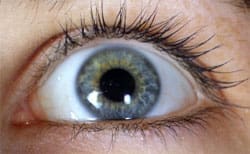Ophthalmic Preparations
Fortified Ophthalmic Preparations

| Fortified ophthalmic drops (Topical) Vision- threatening bacterial infection >1.5 mm diameter ulcer, other. Usual regimen: Fortified tobramycin or gentamicin (14-15 mg/ml) q1h alternating with [ fortified Ancef (50 mg/ml) or Vancomycin (25-50mg/ml) q1h. ] |
| Fortified Ancef (Cefazolin) (50 mg/ml): |
| Reconstitute 1 gram cefazolin powder with 5ml (200mg/ml) sterile water (without preservative) or reconstitute 500mg vial with 2.5 ml. Then you may use any of the following dilutions:
Add 1 ml to 3 ml artificial tears. Final concentration: 50 mg/ml. Refrigerate. Reported stability: 4-7 days. Add 2 ml to 6 ml of artificial tears. Final concentration: 50 mg/ml. Refrigerate. Reported stability: 4-7 days. Add 4 ml to 12 ml artificial tears. Final concentration: 50 mg/ml. Refrigerate. Reported stability: 4-7 days. (Side note: when adding the cefazolin to the artificial tears, aseptically remove the dropper head in a laminar flow hood. Do not attempt to use a needle through the dropper head, which may alter the intended drop size). Alternative: Dilute 500mg vial of cefazolin powder with 10 ml sterile water. Label: Final concentration: 50 mg/ml. Refrigerate. Stability: 7 days. |
| Fortified Gentamicin or Tobramycin: (Usual concentration: 14 mg/ml): |
| Start with the commercially available solution: Gentamicin 0.3% 5ml (15 mg/5 ml) ophthalmic solution or Tobramycin 0.3% 5ml (15 mg/5 ml) ophthalmic solution (. Add 2 ml of gentamicin or tobramycin injection (80mg/2ml) to the respective ophthalmic solution. Label: Concentration: 14 mg/ml. REFRIGERATE, Expires: 7 days. (Side note: when adding the tobramycin or gentamicin to the respective container, aseptically remove the dropper head in a laminar flow hood. Do not attempt to use a needle through the dropper head, which may alter the intended drop size). |
| Vancomycin ophthalmic drops |
| (Usual concentration: 25-50 mg/ml). Some studies have found the 25 mg/mL concentration to have similar efficacy compared to the 50mg/ml concentration and with better patient tolerance.
Preparation (50 mg/ml): Reconstitute 500mg Vancomycin powder with 10 ml sterile water (without preservative). Alternatively, use 10ml of artificial tears. Label: Dosing: (Adult Dose) 1 drop hourly for first 24 hours, then taper gradually according to clinical improvement |
Extemporaneous compounding
 |
General principles involved in the extemporaneous compounding of ophthalmic preparations |
||||||
| There are several important factors to consider when called upon to compound a sterile ophthalmic preparation . In many cases, the drugs involved have a narrow therapeutic range and even small errors when introduced have the potential to cause irreversible damage to the eye. Unfortunately, it is not difficult to locate court cases that have centered around loss of sight of a patient due to a compounding error. The following considerations are recommended whenever you prepare such a product. | |||||||
| 1 | Ensure that there is adequate support in the literature for the product that is prescribed and that the requested concentration is within an acceptable range. Also make sure that there is not a suitable commercial product available that would eliminate the need to extemporaneously prepare a product. The advent of new formulations in the past few years has already drastically reduced the need for many previously compounded items. | ||||||
| 2 | Sterility of the final product is a must: strict adherence to aseptic technique as well as any other preventative measures must be in place. | ||||||
| 3 | The pH of the final product must be within an acceptable range. | ||||||
| 4 | Anticipated stability of the final product must be known, as well as the recommended storage requirements. | ||||||
| 5 | Adequate knowledge of potential diluents or vehicles is required in order to ensure proper tonicity, viscosity, or dissolution of the final product. | ||||||
| 6 | Establishment of written procedures that fully document each step is an important consideration in order to reduce the likelihood of errors. Whenever calculations are required, there should be a secondary source available to verify the accuracy. Also, if multiple dilutions are needed, it is recommended that a new syringe be used for each step in order to minimize the impact of residual contents. One should also use the smallest possible syringe for each measurement in order to increase accuracy. | ||||||
| 7 | If the preparation of a product requires the breaking of an ampule or the reconstitution of a powder (e.g. cefazolin), it is recommended that the final product be filtered prior to packaging in order to eliminate any particulate matter. | ||||||
| 8 | The preparation of intra-ocular products requires the use of preservative-free ingredients. Many preservatives have been found to be toxic to the inner ocular tissues. | ||||||
| 9 | Finally, before dispensing the finished product, always indicate the storage requirements, concentrations of ingredients, and the expected expiration date. | ||||||
References:
|
|||||||
| At a later date, I will be reviewing the various protocols and guidelines available in the literature regarding extemporaneously prepared ophthalmic products. If you have any guidelines you would like to submit , please use the form at the bottom of this page. | |||||||
Navigation
Ophthalmology Related Tables and Apps
- Ophthalmic anesthetics
- Ophthalmic Antibacterials and combination products
- Ophthalmic Anti-allergy agents
- Ophthalmic Antivirals
- Ophthalmic Corticosteroids
- Ophthalmic - Dry eye disease (DED)
- Ophthalmic - Glaucoma
- Ophthalmic Mydriatics
- Ophthalmic NSAIDs
Glaucoma
- Beta blockers
- Prostaglandin analogs
- Alpha-adrenergic agonists
- Carbonic anhydrase inhibitors
- Rho kinase (ROCK) inhibitors
- Fixed Combination Medications
- Preservative-Free Products
- Benzalkonium chloride (BAK)-Free products
- Comparative effectiveness of glaucoma drops
- New Glaucoma Drug Selection tool - Medical App
- Potency of Glaucoma drops - Medical App
- Glaucoma - BAK-free and Preservative-free drops Medical App
- Medical Treatment of Dry Eye Disease (Ophthalmic drops)- Medical App
Other
Latest Research


